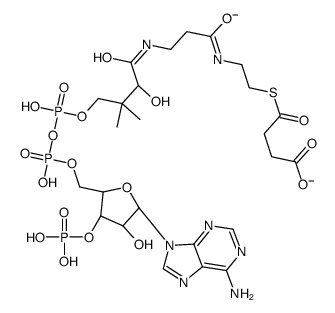Succinyl-Coenzyme A (sodium salt)

Succinyl-Coenzyme A (sodium salt) structure
|
Common Name | Succinyl-Coenzyme A (sodium salt) | ||
|---|---|---|---|---|
| CAS Number | 108347-97-3 | Molecular Weight | 865.59100 | |
| Density | N/A | Boiling Point | N/A | |
| Molecular Formula | C25H38N7O19P3S | Melting Point | N/A | |
| MSDS | Chinese USA | Flash Point | N/A | |
| Symbol |

GHS07 |
Signal Word | Warning | |
Use of Succinyl-Coenzyme A (sodium salt)Succinyl-Coenzyme A (Succinyl-CoA) sodium is an intermediate of the citric acid cycle. Succinyl-Coenzyme A sodium can be converted to succinic acid and can also combines with glycine to form δ-ALA to synthesize porphyrins (heme). Succinyl-Coenzyme A sodium can be used in the study of metabolic, neurological and haematological abnormalities (such as porphyrias) caused by nutritional vitamin B12 deficiency (resulting in a deficiency in Succinyl-Coenzyme A synthesis)[1][2]. |
| Name | Succinyl coenzyme A sodium salt |
|---|---|
| Synonym | More Synonyms |
| Description | Succinyl-Coenzyme A (Succinyl-CoA) sodium is an intermediate of the citric acid cycle. Succinyl-Coenzyme A sodium can be converted to succinic acid and can also combines with glycine to form δ-ALA to synthesize porphyrins (heme). Succinyl-Coenzyme A sodium can be used in the study of metabolic, neurological and haematological abnormalities (such as porphyrias) caused by nutritional vitamin B12 deficiency (resulting in a deficiency in Succinyl-Coenzyme A synthesis)[1][2]. |
|---|---|
| Related Catalog |
| Molecular Formula | C25H38N7O19P3S |
|---|---|
| Molecular Weight | 865.59100 |
| Exact Mass | 865.11600 |
| PSA | 468.30000 |
| Storage condition | 20°C |
| Symbol |

GHS07 |
|---|---|
| Signal Word | Warning |
| Hazard Statements | H315-H319-H335 |
| Precautionary Statements | P280-P305 + P351 + P338-P337 + P313 |
| Personal Protective Equipment | dust mask type N95 (US);Eyeshields;Gloves |
| Hazard Codes | Xi: Irritant; |
| Risk Phrases | 36/37/38 |
| Safety Phrases | 22-26-36 |
| RIDADR | NONH for all modes of transport |
|
Direct biosynthesis of adipic acid from a synthetic pathway in recombinant Escherichia coli.
Biotechnol. Bioeng. 111(12) , 2580-6, (2014) The C6 dicarboxylic acid, adipic acid, is an important platform chemical in industry. Biobased production of adipic acid is a promising alternative to the current petrochemical route. Here, we report ... |
|
|
Functional characterization of a vitamin B12-dependent methylmalonyl pathway in Mycobacterium tuberculosis: implications for propionate metabolism during growth on fatty acids.
J. Bacteriol. 190(11) , 3886-95, (2008) Mycobacterium tuberculosis is predicted to subsist on alternative carbon sources during persistence within the human host. Catabolism of odd- and branched-chain fatty acids, branched-chain amino acids... |
|
|
Acetate formation in the energy metabolism of parasitic helminths and protists.
Int. J. Parasitol. 40 , 387-397, (2010) Formation and excretion of acetate as a metabolic end product of energy metabolism occurs in many protist and helminth parasites, such as the parasitic helminths Fasciola hepatica, Haemonchus contortu... |
| 4-[2-[3-[[4-[[[(2R,3S,4R,5R)-5-(6-aminopurin-9-yl)-4-hydroxy-3-[hydroxy(oxido)phosphoryl]oxyoxolan-2-yl]methoxy-hydroxyphosphoryl]oxy-hydroxyphosphoryl]oxy-2-hydroxy-3,3-dimethylbutanoyl]amino]propanoylamino]ethylsulfanyl]-4-oxobutanoate |